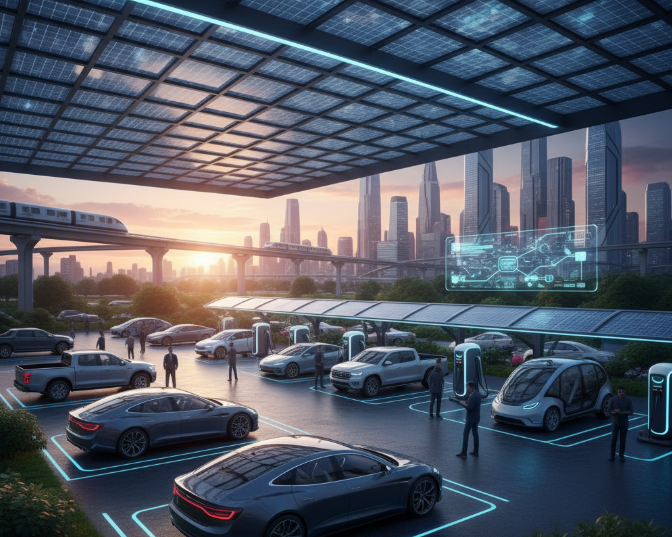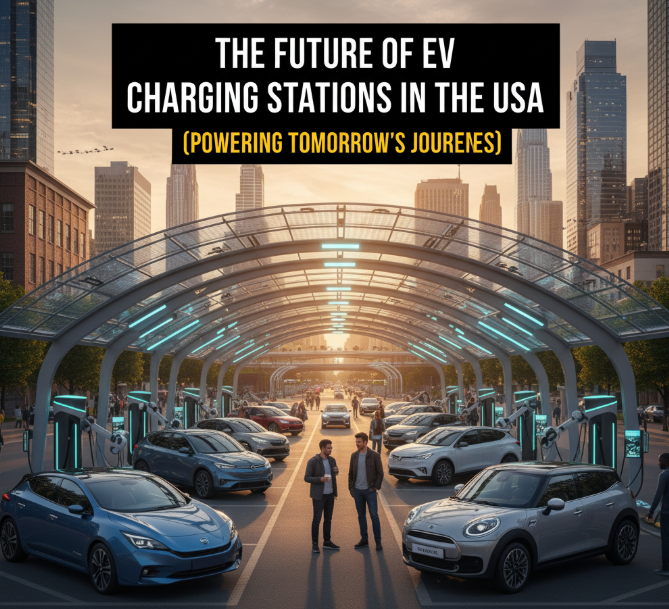Introduction
The United States is going through one of the biggest shifts in transportation history. Electric vehicles (EVs) are no longer a rare sight on highways—they are becoming mainstream. From city streets to suburban driveways, more people are choosing EVs for their efficiency, cost savings, and environmental benefits. But with this growing demand comes a critical question: Will the charging infrastructure keep up?
Gas stations have supported cars for more than a century, but EV charging stations are still in the early stages of development. For the U.S. to fully embrace electric mobility, the charging network must grow, become faster, and more accessible. This article explores what the future holds for EV charging stations in the USA, the challenges ahead, and the innovations that will shape tomorrow’s roads.
The Current Landscape of EV Charging in the USA
Before we look ahead, it’s important to understand where things stand today.
- Total Charging Stations: As of 2025, the U.S. has over 165,000 public charging ports spread across 65,000+ charging stations.
- Types of Chargers Available:
- Level 1 Chargers – Slowest, usually found at homes.
- Level 2 Chargers – Medium speed, common in workplaces, parking lots, and shopping centers.
- DC Fast Chargers – The fastest, capable of charging most EVs to 80% in under 30 minutes.
- Regional Coverage:
- States like California, New York, and Texas lead the way.
- Rural areas and parts of the Midwest still face limited charging access.
📊 Table: Current EV Charging Types in the USA (2025)
| Charger Type | Average Charging Time | Typical Locations | Percentage of Total |
|---|---|---|---|
| Level 1 | 20-40 hours (0–100%) | Homes | 15% |
| Level 2 | 4–10 hours (0–100%) | Workplaces, malls | 60% |
| DC Fast | 20–45 minutes (0–80%) | Highways, stations | 25% |
This foundation is growing rapidly, but experts agree it’s not enough for the surge in EV sales expected over the next decade.
Why EV Charging Stations Matter for the Future
EV charging stations are more than just plug-in spots; they are the backbone of the electric mobility revolution. Here’s why they matter:
- Boosting Consumer Confidence – More visible charging stations reduce “range anxiety,” the fear of running out of battery.
- Supporting Economic Growth – Charging stations bring business to restaurants, malls, and service centers where people spend time while charging.
- Reducing Carbon Emissions – Widespread charging makes it easier to ditch gas-powered cars, leading to cleaner air.
- Enabling Long-Distance Travel – Without a robust charging network, EVs would remain “city cars.” High-speed chargers make cross-country trips possible.
Government Initiatives and Policies
The U.S. government is playing a major role in shaping the future of charging infrastructure.
Federal Plans
- Bipartisan Infrastructure Law (2021): Allocated $7.5 billion for a nationwide EV charging network.
- Goal: Install 500,000 public chargers by 2030.
- Focus: Prioritize highways and underserved communities.
State-Level Initiatives
- California: Aiming for 250,000 chargers by 2026.
- New York: Investing $1 billion in statewide EV infrastructure.
- Texas & Florida: Expanding fast-charging networks along major highways.
Private Sector Involvement
- Companies like Tesla, Electrify America, ChargePoint, and EVgo are investing billions in expanding charging access.
- Oil companies such as Shell and BP are adding EV chargers at traditional gas stations.
Key Trends Shaping the Future of EV Charging
Let’s dive into the most exciting trends that will define how EV charging stations evolve in the coming years.
1. Ultra-Fast Charging Technology
- Next-generation chargers aim to deliver 350 kW to 500 kW power.
- EVs could recharge in 10–15 minutes, similar to a gas station stop.
- Automakers like Porsche, Hyundai, and Tesla are already supporting higher charging rates.
2. Wireless Charging
- Some companies are developing inductive charging pads.
- Drivers may simply park over a charging spot, and the car charges automatically.
- Future vision: charging roads where EVs charge while driving.
3. Smart Charging with AI & IoT
- Stations will use AI to balance energy loads and prevent blackouts.
- Apps will show real-time availability, pricing, and reservation options.
- Vehicle-to-grid (V2G) systems will allow EVs to supply power back to the grid.
4. Renewable Energy Integration
- Solar-powered charging stations are gaining popularity.
- Combining solar + battery storage ensures green energy, even during outages.
- This reduces reliance on fossil-fuel-based electricity.
5. Workplace & Residential Charging Growth
- Employers are adding chargers to attract eco-conscious talent.
- Apartment complexes are investing in charging facilities for tenants.
- Home charging remains the most convenient option for daily commuting.
Challenges Ahead for EV Charging Stations
The road to a fully electrified future won’t be smooth. Here are some of the biggest hurdles:
1. Uneven Infrastructure Distribution
- Cities are expanding rapidly, but rural areas remain underserved.
- Long-distance travel through rural states still requires planning.
2. Grid Capacity Issues
- Mass adoption of EVs could strain the electrical grid.
- Large-scale upgrades and renewable integration are necessary.
3. High Installation Costs
- DC fast chargers can cost $100,000–$250,000 each.
- Smaller businesses may struggle to afford installation.
4. Standardization Problems
- Different automakers use different charging connectors.
- The U.S. is slowly moving toward North American Charging Standard (NACS).
- Until fully adopted, compatibility issues will frustrate drivers.

Future Predictions for EV Charging Stations in the USA
Based on current trends, here’s what we can expect in the coming decade:
- Explosive Growth
- By 2035, the U.S. could have 2 million+ public chargers.
- Fast chargers will account for nearly half of all new installations.
- Gas Stations Will Transform
- Traditional gas stations will add EV charging lanes.
- Charging will come with lounges, cafes, and workspaces.
- Smart City Integration
- Charging will be tied to traffic systems and smart grids.
- Dynamic pricing will encourage off-peak charging.
- Cross-Country Travel Made Easy
- Coast-to-coast EV trips will be as seamless as driving a gas car.
- Charging hubs will be placed every 50 miles on highways.
📈 Chart: Projected Growth of EV Charging Stations in the USA (2025–2035)
Year | Public Charging Ports
-----|----------------------
2025 | 165,000
2027 | 350,000
2030 | 500,000
2035 | 2,000,000+
Opportunities for Businesses and Communities
The future of EV charging isn’t just about cars—it’s about economic and community growth.
For Businesses
- Retailers: Attract customers by installing charging stations.
- Restaurants: Provide fast charging to increase dine-in time.
- Hotels: Offer charging as a value-added service for guests.
For Communities
- Cleaner Air: Less pollution in urban areas.
- Job Creation: Thousands of new jobs in installation and maintenance.
- Tourism Boost: EV-friendly towns attract eco-conscious travelers.
Tips for EV Owners in the Coming Years
As charging evolves, EV owners should be ready to adapt.
- Plan Trips Wisely – Use apps like PlugShare or ChargePoint.
- Check Charging Speeds – Not all chargers deliver the same power.
- Invest in Home Charging – A Level 2 charger at home saves time and money.
- Stay Updated on Standards – NACS connectors will likely dominate by 2030.
- Look for Incentives – Federal and state rebates often reduce home charger costs.
The Bigger Picture: How EV Charging Stations Will Change America
The rise of EV charging stations is more than a technological shift—it’s a cultural transformation. Imagine this:
- Road trips where families stop at solar-powered stations with playgrounds and food courts.
- Cities with curbside chargers on every block.
- Smart highways that keep EVs powered while driving.
Just like gas stations defined 20th-century America, EV charging stations will define the 21st century.
Conclusion
The future of EV charging stations in the USA is bright, dynamic, and full of potential. With government funding, private sector innovation, and consumer demand, the U.S. is on track to build one of the most advanced charging networks in the world.
Yes, challenges like grid strain, high costs, and rural coverage remain—but the momentum is unstoppable. In the next decade, charging an EV will be as simple and common as filling up a gas tank today.
The road ahead is electric, and charging stations are the fuel stops of the future.

Leave a Reply